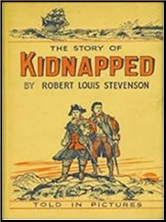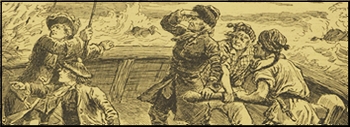Tue 9 Mar 2021
Reviewed by David Vineyard: ROBERT LOUIS STEVENSON – Kidnapped.
Posted by Steve under Reviews[6] Comments

ROBERT LOUIS STEVENSON – Kidnapped. First published in the magazine Young Folks from May to July 1886, and as a novel in the same year.
Young David Balfour has left his home to go to Shaws where his uncle is to turn over the estate he has inherited. Most of you know the story. It is one of the most beloved classics, filmed numerous times since the silent era, adapted on radio, in comic books, and just about any media you can imagine.
First published in a boy’s magazine Kidnapped turns out to be one of the most influential tales ever spun by one of the most popular writers of the 19th Century. Despite having first appeared in a boys’ magazine it is an important story that had wide ranging influence beyond its initial audience, the foundation of an entire genre of popular fiction.

Young David Balfour travels to Shaw House where his scheming uncle plots to have him kidnapped and shipped off. On the ship he has been made cabin boy on, he meets and saves another passenger Alan Breck, a Scottish revolutionary fleeing Scotland after the rebellion.
Though David is a Protestant loyalist and lowlander and Alan a Catholic traitor and Highlander the two form an alliance surviving ship wreck, a desperate journey, a colorful army of eccentrics, traitors, and soldiers, and eventually reclaim Shaws for David and save Alan from the hangman.
Though Stevenson’s Treasure Island had set some of the tropes appearing in Kidnapped, it is in this novel that they all come together in the form that would be most often used in the coming century.
In Kidnapped Stevenson’s avocation of the countryside creates an important character, the wilderness itself, that will come into play in countless imitations.

Kidnapped is the model for a whole genre of British adventure stories that would dominate the thriller for much of the next century. Even Stevenson would revisit the basic form in novellas like “Pavilion on the Linksâ€, The Black Arrow, and The Wrecker where John Buchan would take the form and run with it in his “shockers†that followed the model Stevenson set into the novel of international intrigue.

With the popularity of Buchan’s The 39 Steps the model was established, and the British thriller was born variations on the theme of friendship, betrayal, duality, mystery, pursuit, and chase would dominate books by writers such as Dornford Yates, Geoffrey Household, Hammond Innes, Victor Canning, Gavin Lyall, and Mary Stewart.
Stevenson knew a good thing when he saw it. Kidnapped is also influential in that it was popular enough it inspired a sequel, David Balfour, or Caltronia. I’m partial to the Scribner’s Illustrated edition illustrated by N. C. Wyeth of both the original and the sequel though the later Frank Godwin illustrated edition is a delight as well.
But it is the original, swords and pistols, intrigue and adventure, fogs and chases through the night that gives the book its magic, that and the complex relationship between its two heroes, two very different people whose friendship is forged in danger and pursuit that makes the book a classic and explains the magic that made it one of the most influential stories ever written.

March 9th, 2021 at 11:46 pm
Of all of the “Classics for Kids” books I read as a kid, this was my second favorite. The first? TREASURE ISLAND.
March 10th, 2021 at 1:06 am
There’s a sequel, Catriona. It’s not quite as good, but still well worth reading.
March 10th, 2021 at 1:14 am
I never knew about the sequel, but David mentioned it, too. I’ll have to find a copy, but I’ll have read the original first. It’s been far too long.
March 10th, 2021 at 8:59 am
I have pleasant memories of THE MASTER OF BALLANTRAE and of course “Dr Jekyll and Mr Hyde” both of which show Stevenson as a complex and entertaining story-teller.
March 10th, 2021 at 9:00 am
I was a big fan of Robert Louis Stevenson when I was a kid. Loved TREASURE ISLAND–the book and the movie–and enjoyed KIDNAPPED, too. I’ll have track down a copy of CATRIONA.
March 10th, 2021 at 1:30 pm
I just finished reading Kidnapped, for the first time amazingly, and I am about to start Catriona. I did read Treasure Island more than once as a kid and was completely entranced. If there were ever books perfectly designed to start children and especially boys on a lifetime of reading, these are the ones! The adventures, the plot turns, the characterizations, the atmospheric settings, all superb, and then there is the quality of the prose, which is not bettered anywhere in 19th Century British literature.